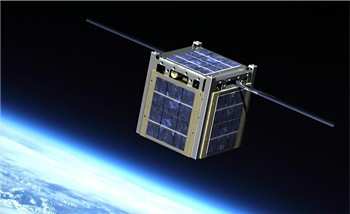Wed, Feb 19, 2014
'The Outernet' Would Utilize Hundreds Of The Small Satellites For Connectivity
A business accelerator focused on independent media delivery systems is incubating its first project: Outernet, which it says is the world’s first truly global media delivery service.

The investors are the Media Development Investment Fund (MDIF), and the project is called the 'Outernet'. Founded by MDIF’s Director of Innovation Syed Karim, Outernet will use a network of small satellites called CubeSats to transmit selected internet data – audio, video, text and applications – to any Wi-Fi-enabled device, including mobile phones, anywhere in the world at no cost. No other information channel allows for such a wide variety of content, or broadcasts on a genuinely world-wide scale.
“We are excited to incubate such a revolutionary project,” said MDIF CEO Harlan Mandel. “Outernet will bypass censorship, ensure privacy and offer worldwide access to information to everyone, including those who today are beyond the geographic reach of the internet or can’t afford it.”
“Outernet is the modern version of shortwave radio,” said founder Mr. Karim. “It uses leading-edge technology to address a deep social problem. As the world moves towards a global knowledge-driven economy, more than 3 billion people are excluded by cost, geography or jurisdiction. Outernet will increase opportunities for everyone to access digital news and information, allowing greater access to opportunity and education than anything that currently exists.”
Outernet will also offer a humanitarian communications system, relaying public service transmissions during emergencies in places where there is no access to conventional communications networks due to natural disasters or man-made restrictions on the free-flow of information.

It embraces the burgeoning new-space startup industry, leveraging multicasting technology to take the Wi-Fi network to an extreme. Anyone with a device will be able to receive the signals, regardless of connectivity to the regular internet. Costly data plans from local telecom operators will no longer be a barrier to accessing information.
All of the components necessary for the Outernet have been validated by various governmental, university and amateur satellite projects. Outernet will bring these technologies together, provide standardization where none exists, and build a genuinely innovative global media delivery platform.
(CubeSat image provided by NASA)
More News
“These new aircraft strengthen our ability to respond quickly, train effectively and support communities nationwide. Textron Aviation has been a steadfast supporter in helpin>[...]
From 2011 (YouTube Edition): Rugged, Legendary, STOL Twin Makes A Comeback The de Havilland Twin Otter is an airplane with a long history, and it gained a reputation as a workhorse>[...]
A Wind Gust Lifted The Right Wing And The Airplane Turned To The Left Analysis: The pilot was departing from a 2,395-ft-long by 50-ft-wide turf runway. The pilot reported that afte>[...]
Have A Story That NEEDS To Be Featured On Aero-News? Here’s How To Submit A Story To Our Team Some of the greatest new stories ANN has ever covered have been submitted by our>[...]
Braking Action Advisories When tower controllers receive runway braking action reports which include the terms “medium," “poor," or “nil," or whenever weather con>[...]
 Aero-News: Quote of the Day (12.18.25)
Aero-News: Quote of the Day (12.18.25) Classic Aero-TV: Viking Twin Otter 400--Bringing the DHC-6 Back Into Production
Classic Aero-TV: Viking Twin Otter 400--Bringing the DHC-6 Back Into Production NTSB Final Report: Rans Employee Flying Club Rans S-6ES Coyote II
NTSB Final Report: Rans Employee Flying Club Rans S-6ES Coyote II ANN FAQ: Submit a News Story!
ANN FAQ: Submit a News Story! ANN's Daily Aero-Term (12.18.25): Braking Action Advisories
ANN's Daily Aero-Term (12.18.25): Braking Action Advisories




